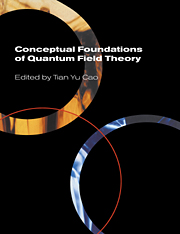Book contents
- Frontmatter
- Contents
- List of contributors
- Preface
- Photographs of the conference
- Introduction: Conceptual issues in quantum field theory
- Part One Philosophers' interest in quantum field theory
- Part Two Three approaches to the foundations of quantum field theory
- Part Three
- Part Four Mathematics, statistics and quantum field theory
- Part Five Quantum field theory and space-time
- Part Six
- Part Seven Renormalization group
- Part Eight Non-Abelian gauge theory
- Part Nine The ontology of particles or fields
- 22 The ineliminable classical face of quantum field theory
- 23 The logic of quanta
- 24 Do Feynman diagrams endorse a particle ontology? The roles of Feynman diagrams in S-matrix theory
- 25 On the ontology of QFT
- Part Ten
- Name index
- Subject index
25 - On the ontology of QFT
Published online by Cambridge University Press: 22 September 2009
- Frontmatter
- Contents
- List of contributors
- Preface
- Photographs of the conference
- Introduction: Conceptual issues in quantum field theory
- Part One Philosophers' interest in quantum field theory
- Part Two Three approaches to the foundations of quantum field theory
- Part Three
- Part Four Mathematics, statistics and quantum field theory
- Part Five Quantum field theory and space-time
- Part Six
- Part Seven Renormalization group
- Part Eight Non-Abelian gauge theory
- Part Nine The ontology of particles or fields
- 22 The ineliminable classical face of quantum field theory
- 23 The logic of quanta
- 24 Do Feynman diagrams endorse a particle ontology? The roles of Feynman diagrams in S-matrix theory
- 25 On the ontology of QFT
- Part Ten
- Name index
- Subject index
Summary
Philosophical introduction
The following seemingly trivial story raises important questions which lead to the philosophical issues essential for our discussion.
My cat is alive and well. I can describe her by size, color, behavior, etc. I can watch her, touch her, play with her, and feed her. I know this animal is really there. But my biologist friend came to visit and informed me that my cat is really nothing but a very complicated collection of different kinds of cells in mutual interaction, and he can prove it to me by having me look through his microscope, and, if I would only let him, by dissecting my cat. But the biochemist next door has a quite different opinion: he claims that my cat is really just a very complex assemblage of organic compounds, proteins, nucleic acids, etc., etc., all in mutual interaction. He, too, can prove his claim.
Of course, physicists know better: a cat, like all matter living or dead, is in last analysis really nothing but atoms bonded together to form the complicated molecules my biochemist friend is talking about. And they can prove that too. But, finally, one cannot ignore the elementary particle people who tell us that atoms are just composed of quarks, gluons, and electrons, so that a cat is really, really just a very complicated assembly of those few types of elementary particles in mutual interaction.
- Type
- Chapter
- Information
- Conceptual Foundations of Quantum Field Theory , pp. 357 - 367Publisher: Cambridge University PressPrint publication year: 1999
- 2
- Cited by

